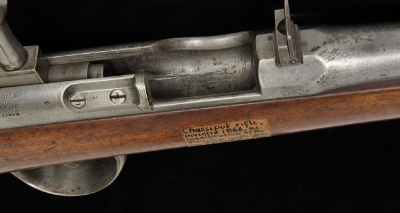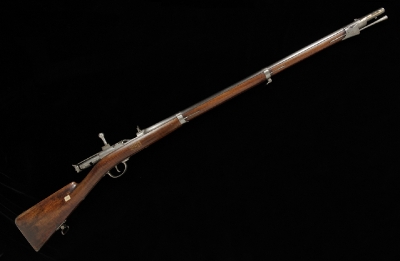Chassepot rifle (1884.27.72)
 Close-up of the Chassepot rifleThe Fusil Mle 1866 ‘Chassepot’ rifle was named after its inventor, Antoine Alphonse Chassepot, foreman of the French Artillery Arsenal. The French had been disconcerted by the superior rate of fire of the Prussian Dreyse needle gun over the Austrians’ old muskets during the Austro-Prussian War of 1866, so they advanced the design of a rival breech-loading needle gun.
Close-up of the Chassepot rifleThe Fusil Mle 1866 ‘Chassepot’ rifle was named after its inventor, Antoine Alphonse Chassepot, foreman of the French Artillery Arsenal. The French had been disconcerted by the superior rate of fire of the Prussian Dreyse needle gun over the Austrians’ old muskets during the Austro-Prussian War of 1866, so they advanced the design of a rival breech-loading needle gun.
Like the Dreyse, the Chassepot also used the new bolt action and combustible paper and linen cartridges. In contrast however, it had a lighter frame, more robust firing pin, higher powder ratio per shot, and a rubber breech-seal, which increased the range to 1,300 yards. Despite more than one million being issued to French troops at the start of the Franco-Prussian War, inadequate command failed to capitalise on its superior performance, resulting in a decisive German victory in 1871. The main drawback of the Chassepot was the build-up of burnt paper residue and black powder fouling. This led to its replacement in 1874 by the Gras rifle, which largely eliminated this problem by using a centre-fire drawn brass unitary cartridge.





